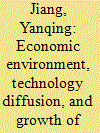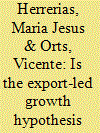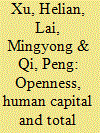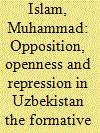|
|
|
Sort Order |
|
|
|
Items / Page
|
|
|
|
|
|
|
| Srl | Item |
| 1 |
ID:
176771


|
|
|
|
|
| Summary/Abstract |
With rapidly expanding real GDP in Vietnam, it is anticipated that the Vietnamese energy production will increase to meet its rising energy consumption. An important corollary is that pollution will also rise since the energy sector is considered a big polluter in the developing world. This paper brings two important insights to this literature: first and foremost, this paper seeks to establish if any behavioural biases of policy makers have clouded the decision to adopt suitable energy technologies and policies in Vietnam with far-reaching consequences for sustainability in the region. Secondly, in order to detect behavioural biases, it considers the asymmetric effects of increases vis-à-vis decreases in regressors by using the non-linear autoregressive distributed lags (NARDL) models, to examine how such increases or decreases really impact on pollution in Vietnam. Using annual data from 1982 to 2015, the analysis finds that the long-run relationships between pollution, energy use and oil prices have been characterised by non-linear and asymmetric interlinkages to indicate hidden cointegration. We further argue that such hidden cointegration can signal important behavioural biases in (energy) policy-making.
|
|
|
|
|
|
|
|
|
|
|
|
|
|
|
|
| 2 |
ID:
105278


|
|
|
|
|
| Publication |
2011.
|
| Summary/Abstract |
This paper examines the effects of the regional economic environment and technology diffusion on China's regional total factor productivity (TFP) growth. We build a model of TFP growth in which Chinese regions achieve growth in TFP by making use of technology spillovers from the world technology frontier. We hypothesize that given the world frontier level of TFP, China's regional TFP growth is positively related to regional openness and negatively related to the current level of regional TFP. Empirical analysis in this paper of 29 province-level regions in China strongly supports our hypothesis. By using a nonlinear least squares regression method, we show that regional openness has a significantly positive effect on regional TFP growth. As a by-product, we also estimate a value of the output elasticity of capital that conforms to its traditionally accepted values. The findings of this paper lend strong support to the claim that the opening up process of China promotes the country's economic growth.
|
|
|
|
|
|
|
|
|
|
|
|
|
|
|
|
| 3 |
ID:
097826


|
|
|
|
|
| Publication |
2010.
|
| Summary/Abstract |
One of the missing pieces preventing us from understanding recent Chinese economic development is the role played by openness and capital accumulation in this process. The question is whether the sharp economic growth that the Chinese economy has experienced is another case of export-led growth due to the open-door policy or whether, on the contrary, this growth has been caused by high domestic savings and investment rates (and the consequent capital accumulation). To answer this question, we employed an empirical framework of the cointegrated vector autoregressive model. The empirical results show that both investment (in physical capital and R&D) and exports, as well as the exchange rate policy, are relevant factors in explaining China's long-run economic growth over the past 4 decades.
|
|
|
|
|
|
|
|
|
|
|
|
|
|
|
|
| 4 |
ID:
088362


|
|
|
|
|
| Publication |
2009.
|
| Summary/Abstract |
This article assesses the prospects of achieving the Millennium Development Goal of halving income poverty in Asia, and identifies policy priorities. The main findings are: (1) in East Asia, the actual growth rate exceeds that required to achieve this goal, while in South Asia, it falls short of the required rate; (2) the required rates of agricultural growth are, however, higher than the actual in both East Asia and South Asia; (3) moderate growth and reduction of income inequality will have a substantial poverty reduction impact; and, finally, (4) even modest improvements in institutional quality will reduce poverty substantially through higher incomes.
|
|
|
|
|
|
|
|
|
|
|
|
|
|
|
|
| 5 |
ID:
102509


|
|
|
|
|
| Publication |
2011.
|
| Summary/Abstract |
This article examines the relationship between economic openness and internal conflict. The article first discusses different theoretical perspectives on how openness affects a country's internal stability and how internal conflict affects openness. Next, empirical estimates of the relationship between conflict and openness are presented, where conflict is measured with both a civil war dummy variable and an events dataset. The correlation between openness and conflict in the data is negative: more open countries have less internal conflict by some measures. However, internal conflict affects the level of openness, which suggests that openness should be treated as an endogenous variable. When the effect of openness on conflict is estimated using instrumental variables or full information maximum likelihood to control for endogeneity, openness does not significantly reduce internal conflict. There is robust evidence, on the other hand, that conflict within a country reduces its international trade. Together, these results suggest that the negative correlation between openness and conflict emerges because stability facilitates international trade rather than because trade flows reduce internal conflict.
|
|
|
|
|
|
|
|
|
|
|
|
|
|
|
|
| 6 |
ID:
082897


|
|
|
|
|
| Publication |
2008.
|
| Summary/Abstract |
This paper examines the drivers behind China's economic growth. In particular, it focuses on the channels of knowledge spillovers: human capital and openness to trade and foreign direct investment. The specific features of the study include using the most recent comprehensive panel data consisting of 29 provinces during the period 1994-2006 and performing unit root and cointegration tests in the panel data framework. The paper finds that human capital, trade and FDI are the significant determinants of total factor productivity, but their importance varies with technological levels of provinces. These findings have important policy implications.
|
|
|
|
|
|
|
|
|
|
|
|
|
|
|
|
| 7 |
ID:
092865


|
|
|
|
|
|
|
|